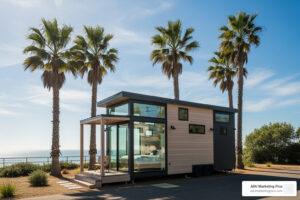California Property Taxes and ADUs: What Homeowners Need to Know
ADU property taxes are a vital topic for California homeowners considering the addition of an Accessory Dwelling Unit (ADU). Let’s get straight to it:
- Yes, building an ADU increases your property taxes. The increase is due to the rise in property value.
- Proposition 13 caps property tax increases, limiting it to 1% of the property’s assessed value with an annual increase cap of 2%.
- ADUs are assessed separately from the primary residence, using a blended assessment method.
In California, owning property often brings a mix of pride and financial complexity. Property taxes, contributing to local services like schools and infrastructure, are a notable part of that equation. Fortunately, Proposition 13 provides homeowners some stability, capping property tax rates at a manageable level. However, when you add an ADU, the dynamics shift.
The good news? The tax hike due to an ADU is usually modest in comparison to the potential rental income or added property value. According to appraiser Jun Ho Lee, ADUs can increase a property’s value by 10-20%, with variances depending on location.

Understanding ADU Property Taxes
Adding an Accessory Dwelling Unit (ADU) to your property in California can be a smart move, but understand how it impacts your property taxes. Let’s break down the key elements involved.
How ADUs Affect Property Taxes
When you build an ADU, your property taxes will increase, but only for the new structure—not your entire property. This is due to the blended assessment approach used in California. Here’s how it works:
- Primary Residence: The assessed value of your main home stays the same. Proposition 13 ensures that only the new construction (the ADU) is reassessed.
- Market Value: The new ADU is assessed based on its market value or construction costs at the time of completion. This value is then added to your existing property assessment.
Your property taxes will rise, but the increase is limited to the value of the ADU itself.
Calculating the Increase
To understand how much your taxes might go up, it’s helpful to look at a specific example, like San Diego:
- Construction Cost: Let’s say you build a 1,000-square-foot ADU. In San Diego, construction costs are often assessed at about $130-$165 per square foot.
- Assessed Value: If your ADU is valued at $165,000 (1,000 sq ft x $165), this amount is added to your existing property assessment.
- Tax Rate: San Diego County’s base property tax rate is 1%, thanks to Proposition 13.
So, in this scenario, your annual property tax would increase by about $1,650 (1% of $165,000).

This increase might seem significant, but remember, the potential rental income from your ADU can often offset this cost. In many cases, the added value and income potential make the investment worthwhile.
For a precise calculation custom to your situation, consulting with a tax professional is always a wise step. They can provide insights specific to your location and construction details, ensuring you’re fully prepared for any tax implications.
Next, let’s explore the tax benefits of owning an ADU.
Tax Benefits of Owning an ADU
Owning an Accessory Dwelling Unit (ADU) isn’t just about extra space or rental income. There are tax benefits that can make it a financially smart choice. Let’s explore the key benefits you can leverage.
ADU Tax Deductions
If you rent out your ADU, you’re in luck. The IRS allows you to deduct several expenses related to your rental unit. This includes:
- Mortgage Interest: Deduct the interest paid on loans used to build the ADU.
- Property Taxes: Any additional property taxes due to the ADU are deductible.
- Insurance Premiums: Coverage costs for the rental unit can be deducted.
- Maintenance and Repairs: Expenses to keep the ADU in good shape are deductible.
- Utilities and Advertising: You can also deduct a portion of utility bills and advertising costs for renting out the ADU.
For those using their ADU as a home office, the IRS offers deductions too. You can deduct a portion of your home’s operating expenses, like utilities and maintenance, based on the space used for business. This can be a great advantage if you’re running a small business from your ADU.
Depreciation and Capital Gains
Depreciation is another powerful tool for ADU owners. The IRS allows you to depreciate the cost of your rental property over 27.5 years. This means you can deduct a portion of the ADU’s cost each year, reducing your taxable income.
Here’s how depreciation works:
- Determine the Depreciation Schedule: For residential properties, it’s 27.5 years.
- Calculate Annual Depreciation: Divide the ADU’s construction cost by 27.5 to find your annual deduction.
For example, if your ADU cost $165,000 to build, you’d deduct about $6,000 annually.
When it comes to selling your property, understanding capital gains exclusion is crucial. If your ADU is part of your primary residence, you might qualify for a capital gains exclusion. This means you could exclude up to $250,000 (or $500,000 for married couples) of the gain from your taxable income if you’ve lived in the home for at least two of the last five years.
This exclusion can significantly impact your financial outcome when selling, making your ADU investment even more attractive.
In summary, navigating the tax landscape for ADUs can offer substantial financial benefits. By understanding and utilizing deductions, depreciation, and capital gains rules, you can optimize your investment for long-term gains.
Next, let’s take a closer look at how ADU property taxes work in California.
ADU Property Taxes in California
Specifics for San Diego and Los Angeles
When you build an ADU in California, your property taxes will increase, but only for the new structure. Thanks to Proposition 13, your primary residence won’t be reassessed. Instead, only the ADU is assessed at its market value or construction cost. This is called a blended assessment.
Proposition 13 and Reassessment Rules
Proposition 13 is a key factor in how property taxes work in California. Passed in 1978, it caps the general property tax rate at 1% of the property’s assessed value. It also limits annual increases in assessed value to 2%, unless there’s new construction or a change in ownership.
For ADUs, this means:
- Only the ADU is reassessed at market value upon completion.
- The primary residence remains assessed at its current value, with a maximum 2% annual increase.
Tax Rate Variations
While Proposition 13 sets the base tax rate at 1%, local taxes and bonds can cause variations. This means your effective tax rate might be slightly higher, depending on where you live.
San Diego County
In San Diego County, the base property tax rate is 1%. The county uses the construction cost to determine the ADU’s assessed value. For example, if your ADU is valued at $165,000, expect an annual tax increase of about $1,650.
Assessors often calculate the cost of construction at “wholesale” rates. These rates can range from $130 to $165 per square foot. So, a 500-square-foot ADU might add $82,500 to your property assessment.

Los Angeles Area
Similarly, in the Los Angeles area, the base tax rate is also 1%, but local taxes might add a bit more. The construction cost per square foot can vary, affecting your ADU’s assessed value.
Just like in San Diego, the assessors in Los Angeles use the construction cost or market value to determine the new assessment for your ADU.
In both areas, it’s crucial to consult with a tax professional to understand the specific impact on your property taxes.
Next, we’ll address some frequently asked questions about ADU property taxes.
Frequently Asked Questions about ADU Property Taxes
Does an ADU increase property taxes?
Yes, adding an ADU will increase your property taxes, but only for the new structure. Proposition 13 ensures that your primary home isn’t reassessed, so only the ADU is evaluated at its market value or construction cost. This process, known as a blended assessment, means your main home’s tax remains stable, while taxes are added for the ADU based on its assessed value.
Can I deduct ADU construction costs?
Yes, you can potentially deduct certain costs related to your ADU, particularly if you use it for rental purposes or as a home office. If you rent out your ADU, you might be able to deduct expenses like property management fees, repairs, and utilities. Additionally, you can depreciate the ADU over time, which helps reduce your taxable income. For ADUs used as a home office, certain expenses like maintenance, insurance, and utilities may be deductible, provided the space is exclusively used for business purposes.
How much will my taxes go up if I build an ADU?
The increase in your property taxes depends on the assessed value of your ADU. In California, the base property tax rate is 1% of the assessed value, but local taxes can add to this rate. For example, in San Diego, if your ADU is valued at $165,000, your annual tax increase would be about $1,650. Assessors often use construction costs to determine this value, with rates ranging from $130 to $165 per square foot. Therefore, a 500-square-foot ADU might add around $82,500 to your assessed value, resulting in an approximate $825 increase in annual taxes. Always consult with a tax professional to get precise figures for your situation.
Next, let’s explore the tax benefits of owning an ADU.
Conclusion
Navigating the complexities of ADU property taxes can seem daunting, but understanding these details is crucial for making informed decisions about your investment. Partnering with experts can provide the clarity and guidance needed to maximize the financial benefits of your ADU.
ADU Marketing Pros is dedicated to helping ADU construction and architecture firms stand out in a competitive market. Our specialized marketing solutions ensure that your expertise is recognized by potential clients who value quality over cost. Learn more about how we can help your ADU business thrive.
Expert consultation is invaluable when considering an ADU project. Tax professionals can offer insights into potential deductions and depreciation benefits, ensuring that you take full advantage of available tax breaks. They can also help you understand local tax variations, such as those in San Diego and Los Angeles, and how these might affect your financial planning.
Financial planning is key to making the most out of your ADU investment. By understanding the tax implications and potential rental income, you can create a strategy that maximizes your returns. Whether you’re using your ADU as a rental unit or a home office, planning ahead can turn your ADU into a pathway to long-term financial prosperity.
In conclusion, while building an ADU involves upfront costs and tax considerations, the potential benefits—both financial and personal—make it a worthwhile endeavor. With the right guidance and planning, your ADU can become a valuable asset that improves your property and boosts your financial future.




